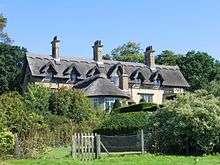How Hill House
How Hill House is a large, Edwardian house located in How Hill, an area in Ludham, Norfolk. The house is on the River Ant and is part of the Broads National Park. It was designed by the English architect Edward Boardman in 1903, who intended it to be his family's country retreat. The Boardman family owned the house until 1966 before its sale to Norfolk County Council, and then to Norwich Union who eventually gifted the house to the How Hill Trust, an environmental education charity. The house is a Grade II listed building.

History
The English architect Edward Boardman decided to build a family retreat within the area known locally as How Hill. He purchased the land, designed the house, and had it built over a period of three years, completing it in 1905. The Boardman family made the house their permanent residence in 1918, after some major expansion.[1] The house became the property of Edward's son, Christopher Boardman, who was notable for winning a gold in sailing at the 1936 Summer Olympics.[2] The house remained in the Boardman family until 1966 when it was sold to Norfolk County Council for £37,000. It then became a residential education centre before closing in 1983, and was sold to the insurance company Norwich Union who leased then gifted it to the How Hill Trust.[1] On 12 May 1987 the house was designated as a Grade II listed building by English Heritage.[3]
Architecture
How Hill House was built to a vernacular Jacobean style in roughcast brick and is laid out in 2-and-a-half storeys. The roof is supported by gabled with moulded timber bargeboards and is covered in thatched roof. The interior remains original and includes a panelled hall, staircase and sitting room.[4] A sun parlour was added to the west of the house in 1910 but was moved six years later. A third, matching chimney stack was added the same year.[1]
Grounds
Just prior to the alteration period in 1910, Edward Boardman had 70,000 trees planted on the estate and set out the formal gardens to the south and the west of the property.[1] His son, Christopher, was given an oak sapling for winning a gold medal at the 1936 Berlin Olympic Games. He planted it in the grounds but it sustained damage during a storm in 1987. In an attempt to save the oak it was pollarded in 2013, but it succumbed to Honey Fungi infestation. A memorial carving of Christopher's achievements in the 1936 Olympic Games was made out of the stump.[5] The tree was one of four remaining oaks in the United Kingdom that were donated by Adolf Hitler prior to the Second World War.[2]
References
- How Hill House, Norfolk Historic Environment Service, accessed 7 June 2016.
- BBC news report- 1936 Olympics oak tree, BBC, accessed 7 June 2016.
- Historic England, "How Hill House (1171918)", National Heritage List for England, retrieved 14 January 2020
- How Hill House, National Heritage List for England, retrieved 24 June 2018.
- "Hitler's Oak Olympic Carving Completed", How Hill Trust, retrieved 24 June 2018.
External links
- Olympic carving on Hitler's oak at the How Hill Trust